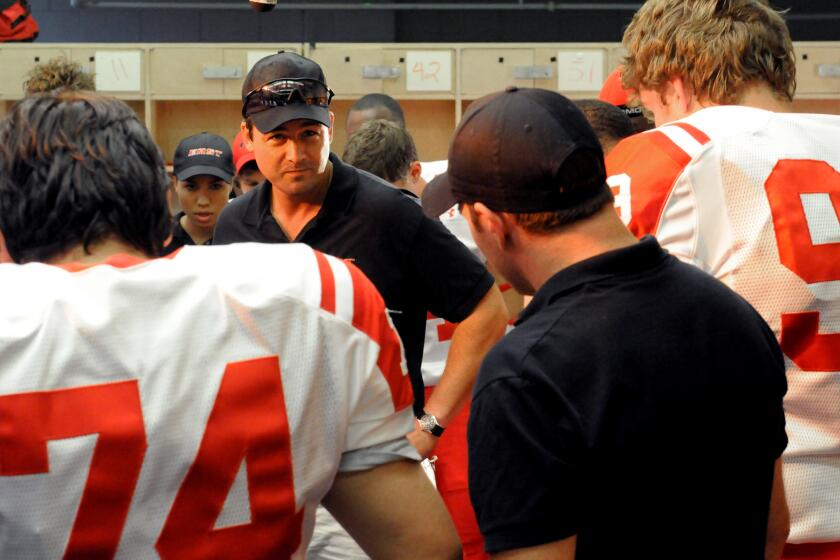The New Age Cleopatra
Discreetly but without a hint of apology, Leonor Varela lifts the hem of her gray silk dress at a table in a posh Beverly Hills hotel. High on her left thigh is a 2-inch pencil-line scar. A sword nicked her, she said, during filming of a battle scene in “Cleopatra,” a new four-hour Hallmark Entertainment miniseries for ABC that begins Sunday.
There is about this 24-year-old half-French, half-Chilean actress--who portrays the ancient Egyptian queen with a modern, spiritual sensibility--an aura of supreme confidence.
Varela, who had her American film debut in a minor role last year in “The Man in the Iron Mask” opposite Leonardo DiCaprio, also leaves her mark on “Cleopatra.” A virtual unknown here, signed two weeks ago by the Endeavor agency, she is one of those dark, smoldering beauties with a luminous face that, well, could launch a thousand ships--or stop them dead in their tracks.
Neither Timothy Dalton’s powerful Julius Caesar, with his piercing blue eyes, dimpled chin and face that belongs on a Roman coin, nor Billy Zane’s sensual Marc Antony--the two key men in “Cleopatra’s” life--eclipses her. Zane, 33, who has morphed from that cad of an aristocratic fiance in “Titanic” into a boyishly appealing leader on “Cleopatra,” awaits Varela at a nearby table. Just after the Oscars--two months after filming wrapped--she and Zane became romantically involved.
“You know, I sometimes feel like I wake up with the makeup of Cleopatra on my face because you cannot go through this part without it leaving stains on you,” said Varela, who was born in Chile and spent her childhood in Colorado and Germany before moving to Paris. “That scar means a lot to me because it is the embodiment to prove that she went through me. . . .
“It was a big challenge to say, ‘What are you going to bring new to the role? What are you going to do now?’ ” she said, well aware of the Cleopatras who have preceded her on the Shakespearean stage and on screen, including Claudette Colbert, Vivien Leigh and Elizabeth Taylor.
“So after a week of panic where I read as much as I could . . . I just really attacked the work and grabbed the character’s body and tried to fit in it. It was a pleasure going through the process of making this woman, this amazing woman, go from a 20-year-old virgin to an accomplished woman, sovereign and a mother. [She] has values to her vision of life, meaning ‘I want the world to be a better place.’ And I wanted to let her have little failures, humanity.”
Director Franc Roddam chose her, she said, after she and Kassandra Voyagis, who plays Cleopatra’s sister Arsinoe, read each role. “So there was this built-in rivalry which was very stimulating, and whoever dominated the other in that room got the part. I guess I did my job,” she said, laughing.
The lavish $30-million production, of course, is a major player itself. Executive-produced by Robert Halmi Sr. and Robert Halmi Jr., it was filmed in Morocco and at Shepperton Studios outside London. By the time it wrapped, “Cleopatra” had used 1,000 extras, 600 horses, 40-foot-thick walls, a ton of copper, 2,000 costumes, 1,500 pieces of jewelry, 300 wigs and a rebuilt city of Alexandria, measuring a quarter mile from one end to the other.
“The first time I arrived in Morocco,” Varela said, “Franc took me by the hand and walked me from [Cleopatra’s] boat all the way up to the palace steps, [and said] ‘Here, my love, let me show you your palace.’ ”
So how does Roddam take viewers by the hand and make a nearly 2,100-year-old story resonate today?
“It should be epic--people are expecting that,” said Roddam, a British director best known for Halmi Sr.’s “Moby Dick” (1998) on USA Network and the teen cult movie “Quadrophenia” (1979). “But then if it’s only epic, [people] won’t be able to relate to it totally. So you make it intimate as well. Intimate in its dealing with relationships.
“I see a woman trying to hang onto something that men are trying to take from her. Egypt, in this instance. Whereas it could be a corporation, it could be family. She knows she has to deal with the world of men and work her way through it.”
Roddam suggests that each “Cleopatra” reflects the period in which it was made. “Watch the [Richard] Burton-Taylor film. It’s all about [fighting] with each other, and like ‘50s [Las] Vegas colors. [In our production, she] is a female who actually has rights and defends those rights. This is slightly more New Age-y.”
From Roddam’s perspective, Caesar really did love Cleopatra, and their son, Ptolemy Caesar, is an important part of the story. “In Caesar, you have this powerful father-like figure teaching her; and with Marc Antony, a much more passionate, a little bit more unstable man; and with Octavius [Rupert Graves]”--later known as Augustus, who became the first Roman emperor--”you have the bureaucrat--slightly effete. Somebody who thought pleasure was indecent almost. Bureaucrats do tend to win. . . .
“I think Caesar really was taken by her beauty,” Roddam continued, “and older men sometimes see a boldness in a young woman. . . . In terms of Marc Antony, that was a more equal passion.”
Dalton, 53, whose roles range from Marc Antony (twice) on the London stage to James Bond on screen (“The Living Daylights,” “License to Kill”) to Rhett Butler in the 1994 miniseries “Scarlett” for CBS, calls Caesar a remarkable man. But he quickly makes the distinction between someone who is great but not good.
“I would not admire someone who wanted to dominate the world,” said Dalton, very un-Caesar-like in a rumpled T-shirt with sunglasses hanging around his neck. “You admire that tenacity, that ruthlessness, that ambition, that political skill--from a distance. It was important to remind the audience that he did have quite a searing ambition to be almost a god . . . [in a scene] by the Sphinx when he talked about not wanting to be remembered in crumbling stone, that he was going to shape the world for history to come.
“Caesar nearly loses to Cleopatra, nearly loses his focus. He says in our movie, ‘I have to go. When I’m with you, I lose myself.’ Antony never has the strength to do that.”
“Dying for love,” says Billy Zane of Marc Antony, “is all you could really ask for in a dramatic part.”
The Cleopatra he falls for is “an exquisite character and Marc Antony fell right into this spell.”
Zane, who had extensive cross-continental phone discussions with Roddam about how to find a contemporary context for the story long before shooting began, explained: “In the ‘30s version [Colbert] is in an Art Deco palace, she was a modern woman, a bit of a vamp. Elizabeth Taylor was clearly a product of America in the late ‘50s and ‘60s, foreign policy during the Cold War, very congratulatory and celebratory of the militant stance that Rome took. Today, on the brink of a new millennium, we’re dealing with spiritual themes, metaphysical realms. . . . Cleopatra was channeling the best of the energies of the goddess Isis . . . to create a new golden age of light, and this was completely threatening to Rome.”
As for Varela, their love scenes on “Cleopatra” are passionate and artful, Zane noted: “We had built this relationship on friendship, on trust, on working together, and naturally a love was growing, and very uncommon and surprising.”
Off-Screen Attraction, On-Screen Chemistry
But still just a friendship? “Well, yes, even if there were rumblings for it. I think it served the experience better to have that restraint. You can see it. It percolates. It crackles on-screen, because it’s unrealized,” he said, grinning.
Roddam, who came onto the project six weeks before filming, oversaw “adjustments” to the script, written by Stephen Harrigan and Anton Diether, to fit the actors he had cast. In crafting the story, he takes some liberties with history and with the 957-page 1997 novel, “The Memoirs of Cleopatra” by Margaret George, on which the production is based. Still, for everything there is a historical context, though not always the expected. Roddam compares Caesar’s arrival in Alexandria with Hitler’s entry into Paris. And the scene Roddam created of the ramrod-straight conqueror riding his chariot to the palace is replete with extras, horses and red banners. He contrasts that with Marc Antony, who walks into the palace surrounded by flowers and children, and likens that to President John F. Kennedy in Berlin.
Though at the moment of his assassination Caesar won’t say the classic Shakespearean line “Et tu, Brute?,” Cleopatra will be slowly released from a carpet. “If I did ‘Cleopatra” and didn’t do the carpet, people would be so disappointed.
“I wanted to make a popularist piece,” said Roddam. “This is not art house cinema. . . . I wanted to give access to the grandeur and beauty by not being too intellectual, too historical, by saying, ‘It’s a good tale, loves. Why don’t you enjoy it?’ ”
*
* “Cleopatra” airs on ABC on Sunday and Monday from 9 to 11 p.m. The network has rated it TV-14 (may be unsuitable for children under the age of 14).
The complete guide to home viewing
Get Screen Gab for everything about the TV shows and streaming movies everyone’s talking about.
You may occasionally receive promotional content from the Los Angeles Times.



